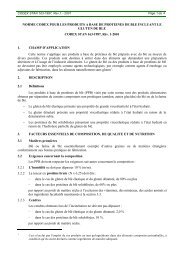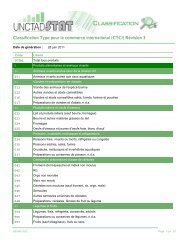Purchase for Progress (P4P)
Purchase for Progress (P4P)
Purchase for Progress (P4P)
Create successful ePaper yourself
Turn your PDF publications into a flip-book with our unique Google optimized e-Paper software.
<strong>Purchase</strong> <strong>for</strong> <strong>Progress</strong> (<strong>P4P</strong>)Connecting Farmers to Markets
Presentation Objectives• What isWFP?• What is <strong>P4P</strong>?• Where arewe?
What is WFP?•Largest humanitarian organization•Works in 91 countries•Fed more than 1.4 billion•Budget of US$ 6.4 billion•10,100 employees; 91% in the field•Voluntarily funded
<strong>P4P</strong>’s Two Key QuestionsOBJECTIVES 1 & 2Assessment CriteriaWhat procurementmodalities/plat<strong>for</strong>ms* bestsupport capacity building andcreate an enabling environment<strong>for</strong> procurement from smallholderfarmers?GroupmarketingcapacityProduction /productivityresponseLivelihoodimprovement*Modalities include direct and <strong>for</strong>ward contracts, soft tendering, warehouse receipt systems, commodity exchangesOBJECTIVES 3 & 4What is the best way <strong>for</strong> WFP tobalance the risks and costsassociated with pro-smallholderprocurement in order to optimiseand trans<strong>for</strong>m it’s localprocurement practices?Scale ofprocurement,timeliness, cost,efficiency andquality/safety ofprocured foodMarketdevelopmentimpactImpact onlivelihoods ofsmallholderfarmers
Procurement ModalitiesCompetitive ProcessesLocal & Regional Procurement, “soft” tendering,Warehouse Receipts Systems, Commodity exchangesDirect ContractingForward Contracting
Targeted <strong>P4P</strong> Market Entry PointsConsumersRetailersWFP Point of EntryRP/LPLarge-scale Food Processors/Large-scale Millers/Large-scale WholesalersWFP Point of EntryRP/LPWFP <strong>P4P</strong>Point ofEntryBlended Food orSmall-scale ProcessorsFarmer OrganizationsThrid TierSecond TierFirst Tier*Levels and characteristics of FOs aredifferent in each <strong>P4P</strong> countryWarehouseReceiptsSystemMedium-scaleTradersCommodityExchangeSmall-scale Traders(Collectors)WFP <strong>P4P</strong>Point ofEntryAgricultural. inputs & servicesSmallholder Farmers
Strategic PartnershipsCREDITGovernments, IFAD,IFC, Banks andMicrofinance InstitutionsPRODUCTION INPUTSGovernments, NGOs,FAO, AGRA, BilateralPartners and PrivateSectorQUALITYGovernments, FAO,NGOs, ResearchInstitutions and PrivateSectorPOLICY & ADVOCACYGovernments, RegionalEconomic Communities,NGOs, Media, Universitiesand Private SectorFarmerOrganizationsMARKET ACCESSGovernments, FAO, IFAD,AGRA, Regional EconomicCommunities, ResearchInstitutions, Universities andPrivate SectorCAPACITY DEVELOPMENT(Skills, Market Analysis, Post-harvestHandling, etc.)Governments, IFAD,AGRA,FAO, Regional EconomicCommunities, NGOs andUniversities, Private SectorINFRASTRUCTUREGovernments, AU, IFAD,World Bank and BilateralProgrammes, PrivateSector
Indicators <strong>for</strong> LearningIllustrative Indicators <strong>for</strong> <strong>P4P</strong> Learning FrameworkFrameworkAssessment CriteriaGroup marketingProductionHousehold welfareBest practicesmodels will becompared on thebasis of their:Impact on farmergroups:•Organizationalcapacity•Financial capacity•Capacity toaggregate•Infrastructure•Access to marketsEffects on:•Agricultural production•Yields•Cropping patterns•Investments inagricultureImpact on:•Number of smallholder farmers engaged•Annual household incomes•Food consumption score•Livelihood/wealth index•Other indicators of household welfare (e.g. health andeducation access, housing quality)•Net buyer/seller statusTrans<strong>for</strong>mingWFP’s localprocurement willrequire a clearunderstanding ofthe benefits interms of:•Number of smallholders engaged•Smallholder household income and other welfare measures•Procurement cost (food cost and administrative cost)•Pipeline risks•Market impacts (positive and negative)•Market development impacts•Agricultural development impacts
How We Learn• Field visits• Trainings• Documentation,Reports & Guidance• Meetings,Consultations &Workshops• E-tools
Implementation Status1 st QuarterSept – Dec 20082 nd QuarterJan-March 20093 rd QuarterApril- June 20094 th QuarterJuly – Sept 2009Bill & Melinda Gates Foundation Funded CountriesBurkina FasoEthiopiaUnder approvalKenyaUnder approvalMalawiMaliMozambiqueRwandaUnder developmentTanzaniaUgandaZambiaUnder approval
Implementation Status1 st QuarterSept – Dec 20082 nd QuarterJan-March 20093 rd QuarterApril- June 20094 th QuarterJuly – Sept 2009Other <strong>P4P</strong> CountriesAfghanistanUnfundedDraftDRCDraftEl SalvadorGhanaUnfundedGuatemalaHondurasLaosLiberiaUnfunded exceptassessmentNicaraguaSierra LeoneSudanUnder approvalUnder development
Good• Intense Interest• Long-termperspective•Timely• Learning• On track
Bad• Under-estimationof start-up time• Over-expectations• Rush to judgment• Some partnershipsslow to take off…
Ugly• Risks identified areoccurring:o Resource <strong>for</strong> food purchaseo Climatic shockso Commodity pricing• Political pressures• Fear by others ofmission creep
What We Are Learning• Programme Design• ProgrammeImplementation• Partnerships andTraining• Policy Advice andAdvocacy• Monitoring andEvaluation• Budget management
<strong>P4P</strong> Graduation ConceptMature Farmer OrganizationsCharacteristics:• Regularly participating in competitive tendering with WFP& other institutional buyers• Participating in trading plat<strong>for</strong>ms such as CEXs, WHRs• Selling higher up the market chain• Have wide range of buyers (not reliant on single buyer)SupplyDemand• World Food Programme• Government reserve agencies,hospitals, schools• International agencies• Traders at various levels• Food industryDeveloping Farmer OrganizationsTargeted supply-side support to:• Address credit constraints• Enhance commercialization skills (negotiation & pricing knowledge)• Promote business management & negotiation skills, market in<strong>for</strong>mation & knowledge• Train on quality improvement• Support access to storage• Train on handling, bagging & transportationObjective <strong>for</strong> members:1. To have improved production/productivity and post-harvest management &2. Be willing to engage in group marketing/aggregation



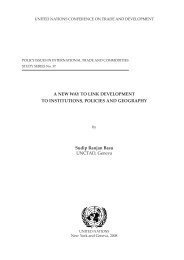
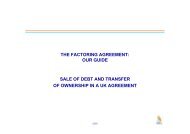
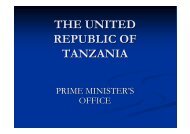
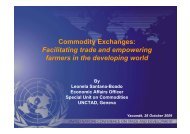
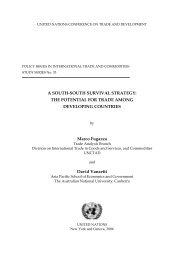
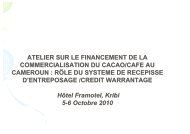
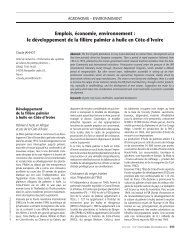
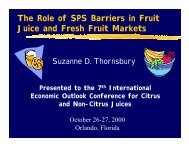
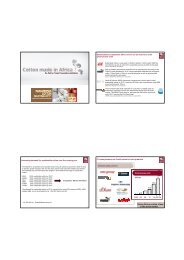
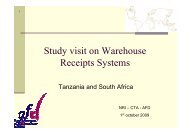
![Warehouse Receipt Systems: Legal Issues [PDF]](https://img.yumpu.com/43979338/1/190x134/warehouse-receipt-systems-legal-issues-pdf.jpg?quality=85)
